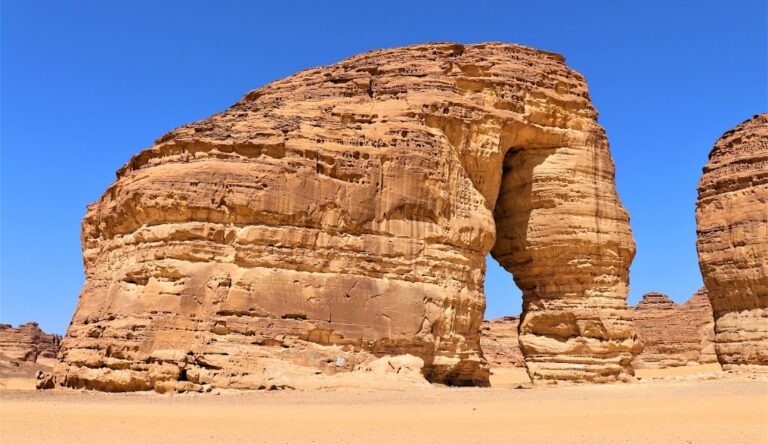
Madain Saleh stands as a testament to Saudi Arabia’s rich historical heritage. This archaeological marvel, nestled amidst the vast desert landscape, holds within its sandstone walls the echoes of ancient civilizations and the whispers of bygone eras. Let’s embark on a journey to unravel the mysteries and magnificence of this extraordinary site.
Geographical Context
Located in the northwest of Saudi Arabia, Madain Saleh sits within the region of Al-Ula. Surrounded by towering sandstone cliffs and expansive desert vistas, the site exudes an aura of timeless grandeur.
Historical Background
Nabatean Civilization
At the heart of Madain Saleh’s history lies the Nabatean civilization, which flourished in the region over two millennia ago. Originating from southern Arabia, the Nabateans established a network of prosperous cities along vital trade routes.
Trade Routes and Prosperity
The strategic location of Madain Saleh facilitated its role as a vital hub along the incense and spice trade routes. Caravans laden with precious goods traversed the desert, enriching the Nabatean kingdom and fueling its cultural and architectural achievements.
Architectural Wonders
Tombs and Facades
One of the most striking features of Madain Saleh is its intricate rock-cut tombs and facades. Carved into the sandstone cliffs, these monumental structures showcase the artistic prowess and engineering ingenuity of the Nabateans.
Al-Ula City
Adjacent to Madain Saleh lies the ancient city of Al-Ula, characterized by its well-preserved ruins and urban layout. The city’s architecture reflects a sophisticated understanding of urban planning and design, with intricate water management systems and residential quarters.
Cultural Significance
Religious Practices
Madain Saleh served as a religious center for the Nabateans, with temples and sacred sites dotting its landscape. The site’s religious significance transcended cultural boundaries, attracting pilgrims from distant lands.
Art and Sculpture
The artistry of Madain Saleh’s rock-cut sculptures and inscriptions provides insights into Nabatean beliefs and rituals. Symbols of deities, celestial bodies, and mythical creatures adorn the walls, offering glimpses into ancient cosmologies.
Conservation Efforts
UNESCO World Heritage Site
In recognition of its outstanding universal value, Madain Saleh was designated as a UNESCO World Heritage Site in 2008. This prestigious status underscores the importance of preserving and safeguarding the site for future generations.
Tourism and Sustainability
As tourism to Madain Saleh continues to grow, efforts are underway to balance visitor access with environmental conservation. Sustainable tourism initiatives aim to minimize the ecological impact while maximizing the socio-economic benefits for local communities.
Visitor Experience
Tourist Attractions
Visitors to Madain Saleh can explore a multitude of attractions, from the towering Qasr Al-Farid tomb to the intricately carved Lion Tombs. Guided tours offer insights into the site’s history and significance, allowing visitors to delve deeper into its mysteries.
Accommodation and Facilities
Accommodation options in Al-Ula cater to a range of preferences, from luxury resorts to traditional Bedouin camps. Hospitality services ensure a comfortable and immersive experience, with opportunities to savor local cuisine and hospitality.
Local Community
Impact of Tourism
The influx of tourists to Madain Saleh has brought both opportunities and challenges to the local community. Economic development initiatives aim to empower local residents and preserve their cultural heritage amidst rapid changes.
Cultural Exchange
Interactions between visitors and the local community foster cultural exchange and understanding. Initiatives such as community-based tourism provide opportunities for authentic experiences and meaningful connections.
Future Prospects
Development Plans
Ambitious development plans seek to enhance the visitor experience while preserving the integrity of Madain Saleh. Infrastructure projects aim to improve accessibility and amenities, ensuring that the site remains accessible to future generations.
Challenges and Opportunities
As Madain Saleh embarks on a new chapter of growth and development, stakeholders must navigate challenges such as balancing tourism demands with conservation priorities. By embracing sustainable practices and fostering community engagement, Madain Saleh can continue to shine as a beacon of cultural heritage and historical significance.
Conclusion
In the heart of the Saudi Arabian desert, Madain Saleh stands as a testament to the enduring legacy of the Nabatean civilization. As visitors traverse its ancient pathways and marvel at its architectural wonders, they become part of a timeless narrative that transcends borders and spans centuries.
Frequently Asked Questions (FAQs)
1. What is the best time to visit Madain Saleh?
- The best time to visit Madain Saleh is during the cooler months of October to March when temperatures are more bearable for exploring the desert landscape.
2. Are there guided tours available at Madain Saleh?
- Yes, guided tours are available at Madain Saleh, offering insights into the site’s history, architecture, and cultural significance. Visitors can choose from a variety of tour options to suit their interests and preferences.
3. Is Madain Saleh suitable for families with children?
- Madain Saleh offers opportunities for families to explore together, but parents should be mindful of the desert environment and ensure children stay hydrated and protected from the sun.
4. Are there accommodation options near Madain Saleh?
- Yes, there are accommodation options available in the nearby city of Al-Ula, ranging from luxury resorts to traditional Bedouin camps. Visitors can choose accommodations that suit their preferences and budget.
5. How can I contribute to the conservation efforts at Madain Saleh?
- Visitors can support conservation efforts at Madain Saleh by adhering to site regulations, practicing responsible tourism, and participating in initiatives that promote environmental sustainability and cultural preservation.